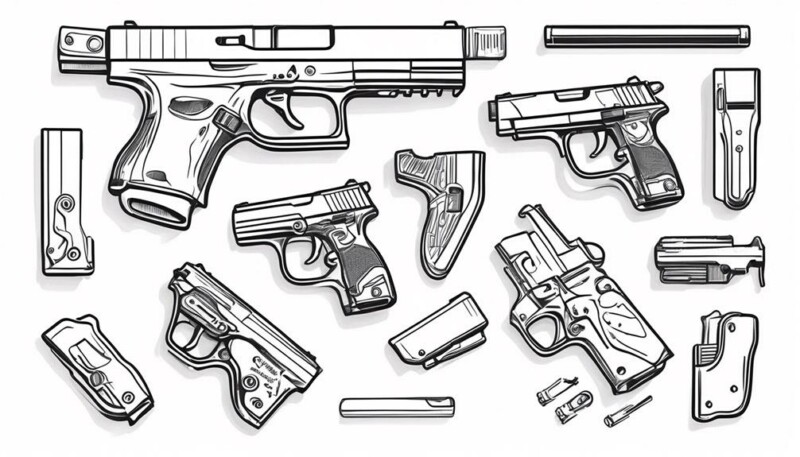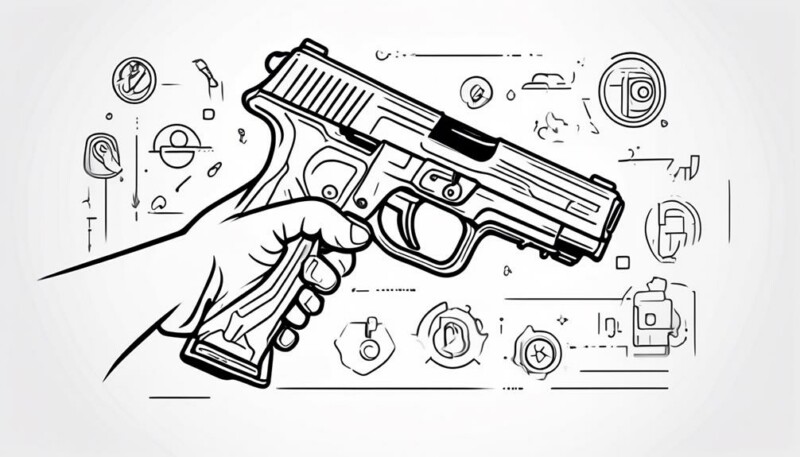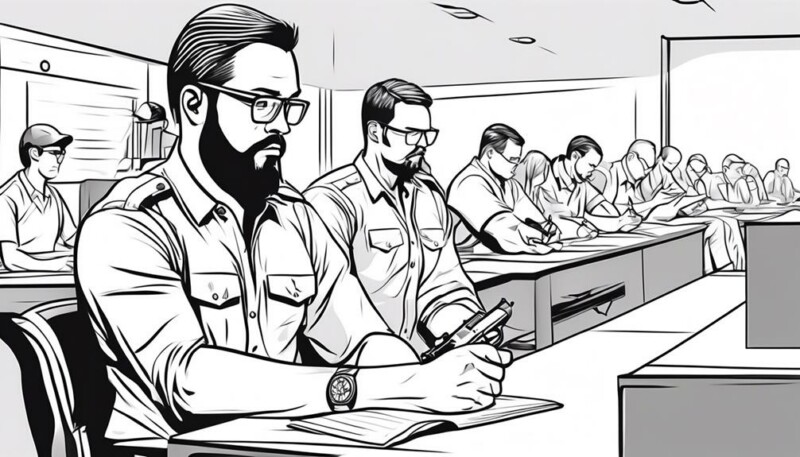Stepping into the world of concealed carry is like gaining a new appendage; it changes the way you move, the way you think, and adds a significant level of responsibility to your daily life. As a beginner, there's a wealth of information you need to absorb, from laws and regulations to the practical aspects of carrying a concealed weapon.
To help you navigate these uncharted waters, we've compiled 8 essential safety tips that provide a starting point for your journey. These tips, though they're just the tip of the iceberg, will give you a solid foundation to build upon, ensuring you start off on the right foot.
But keep in mind, there's a lot more to explore and understand in the vast realm of concealed carry.
Key Takeaways
- Familiarize yourself with local laws and regulations regarding concealed carry to ensure compliance and avoid legal complications.
- Regular practice and continuing education are essential for enhancing shooting accuracy, developing muscle memory, and staying up-to-date with concealed carry laws.
- Understanding your firearm thoroughly, including its specifics, recoil, and trigger control, is crucial for shooting accuracy and overall proficiency.
- Practice safe and discreet carry techniques, such as building muscle memory for holster draw, dressing appropriately for concealment, and following firearm handling and safety measures.
Understanding Concealed Carry Basics
To ensure your safety and legal compliance, it's crucial that you understand the basics of concealed carry, from consistently practicing for self-defense readiness, familiarizing yourself with local laws and regulations, to dressing appropriately for discreet carry. Here are some Concealed Carry Tips to help you navigate the complexity of carrying a concealed firearm.
Before you decide to carry, invest time in understanding concealed carry basics. This includes knowing your local laws and regulations. Some states require a permit to carry concealed firearms, so always be sure you're legally compliant. Also, avoid alcohol consumption when carrying, as it can impair your judgment and reactions.
Consistency is key when it comes to self-defense readiness. Carry your firearm regularly so that you become comfortable and proficient with its use. Remember, the purpose of carrying concealed is to be prepared for unexpected situations, not to intimidate or boast.
Dressing appropriately is another crucial aspect. Your attire should be comfortable and capable of effectively concealing your firearm. Research different carry methods and equipment to find what works best for you.
Following these tips can help ensure your safety, legal compliance, and effectiveness when carrying concealed. Remember, understanding the basics is the first step to becoming a responsible gun owner.
Importance of Regular Practice
It's crucial to understand the role regular practice plays in concealed carry safety.
Not only does it enhance your shooting accuracy, but it also helps you understand your firearm better.
Consistent practice will build muscle memory, improve your reaction times, and ultimately make you a safer and more effective gun owner.
Enhancing Shooting Accuracy
Honing your shooting accuracy through regular, disciplined practice is critical not only for building muscle memory but also for mastering your holster draw and shooting techniques.
Whether at a shooting range or at home with an unloaded firearm, consistent practice is vital. Besides enhancing shooting accuracy, it also develops split-second decision-making skills, essential when you carry a concealed firearm.
Participating in structured firearms training can provide necessary feedback, helping to correct any flaws in your techniques. Remember, it's not just about hitting the target, it's about readiness to draw and fire without hesitation in a life-threatening situation.
Understanding Your Firearm
Building on the notion of disciplined practice, understanding your firearm inside and out becomes equally significant, not just for boosting accuracy but for bolstering your overall confidence and proficiency in handling and shooting. It's essential when you decide to carry a gun, especially concealed firearms.
The table below highlights some practical tips to better understand your firearm:
| Tips | Description | Importance |
|---|---|---|
| Regular practice | Engage in consistent practice at the shooting range | Develops muscle memory and refines shooting skills |
| Know your firearm | Familiarize yourself with your firearm's specifics | Helps in efficient operation and handling |
| Recoil management | Understand your firearm's recoil and trigger control | Enhances shooting accuracy |
When you start carrying, remember, your proficiency and readiness to use your firearm effectively stems from understanding your firearm thoroughly.
Legalities Surrounding Concealed Carry
Before you strap on your holster, it's crucial to understand the legalities surrounding concealed carry.
You must familiarize yourself with the laws in your area, the importance of obtaining the correct permits, and the potential consequences of non-compliance.
Staying well-informed helps you to avoid legal complications and ensure responsible, lawful concealed carry.
Understanding Concealed Carry Laws
To navigate the complex landscape of concealed carry, it's critical that you thoroughly research and understand the concealed carry laws specific to your state, ensuring you're always in compliance. Grasping these laws won't only keep you on the right side of the law but also enhance your overall safety.
Here are some practical steps towards understanding concealed carry laws:
- Regularly check for changes in laws in your state. These can affect your right to carry concealed.
- Understand the concept of 'permitless concealed' carry and whether it applies in your state.
- Research reciprocity agreements with other states. This is important if you travel with your firearm.
- Identify zones where concealed carry is prohibited.
Stay informed, stay safe.
Permits and Their Importance
After familiarizing yourself with state-specific concealed carry laws, it's crucial you understand the importance of obtaining a permit, which serves as your legal authorization to carry a concealed firearm. Permits and their importance can't be overstated; they help you avoid legal complications and demonstrate to law enforcement officers that you're carrying within the law. Not all states allow concealed carry without a permit, so obtaining one will ensure you're legally covered.
| Importance | Result |
|---|---|
| Understanding legal requirements | Avoid legal complications |
| Obtaining permit | Legal authorization to carry |
| Complying with state laws | Exercise Second Amendment rights legally |
| Carrying permit when armed | Proof for law enforcement officers |
| Knowing states allow concealed carry | Avoid legal trouble in different states |
Remember to always carry your permit when armed.
Consequences of Legal Non-compliance
Ignoring the legalities surrounding concealed carry can land you in hot water, so always familiarize yourself with the laws and regulations in your area. If you're not allowed to carry concealed in certain places, respect these restrictions. Remember, the consequences of legal non-compliance are severe.
- Always carry necessary permits and licenses.
- Avoid carrying concealed in prohibited areas.
- Never carry while under the influence of alcohol.
- Know the legal protocols when interacting with law enforcement.
Failing to adhere to these rules could result in fines, imprisonment, or the loss of your rights to carry. Stay informed and respect the law. That way, you'll not only protect yourself but also those around you.
Choosing the Right Equipment

When it comes to concealed carry, picking the right equipment – a comfortable, concealed carry method, a secure holster, and a firearm that suits your body type and lifestyle – is a crucial first step. Your comfort, safety, and the effectiveness of your carry concealed setup depend on choosing the right equipment.
Consider the following table to guide you on your journey to the best concealed carry setup:
| Item | Considerations |
|---|---|
| Carry Method | Prioritize comfort and concealment. |
| Holster | Should securely retain your firearm and prevent printing. |
| Firearm | Must suit your body type and daily activities. |
| Quality | Invest in reliable and durable equipment. |
Don't just rush to the nearest local gun shop and pick the first holster and firearm you lay your eyes on. Seek professional advice and try out different options. The best concealed carry setup is the one that feels right and works best for you. Remember, a poorly chosen setup can compromise your safety and the effectiveness of your concealed carry. Make the right choices and stay safe.
Safe and Discreet Carry Techniques
Mastering safe and discreet carry techniques is crucial for any concealed carry beginner, as it ensures not only your safety but also the comfort and confidence in daily activities. These techniques form the bedrock of carrying a gun and are pivotal concealed carry safety tips for beginners.
Here are some key strategies to adopt:
- Practice holster draw with an unloaded firearm at home, and hit the range for real-life scenarios. This will help build muscle memory.
- Avoid adjusting or repositioning your holster in public. It's essential to maintain a discreet appearance and not draw attention.
- Always have your permit handy if required, and remember, never carry a concealed firearm while consuming alcohol.
- Dress appropriately. Choose clothes that comfortably and discreetly conceal your firearm. A minimalistic holstering system can help prevent printing.
Lastly, don't forget to research and understand the concealed carry laws in your state. Know about reciprocity and ensure you've obtained the necessary training for responsible carry. These aren't just tips but rules, so follow them diligently.
Firearm Handling and Safety Measures

With a concealed carry permit comes a great responsibility, particularly when it comes to firearm handling and safety measures. Remember, the key concealed carry safety principle is always treating your firearm as if it's loaded.
Never point it at anything you don't intend to shoot. This is one of the most fundamental concealed carry safety tips for beginners. Secondly, always be aware of your target and what's beyond it. A stray bullet can have disastrous consequences.
When it comes to firearm handling, your finger should never be on the trigger until you're ready to shoot. Keep it along the frame or slide. Also, keep your firearm clean and well-maintained. A neglected gun is prone to malfunction which can pose serious safety risks.
Lastly, proper storage of your firearm when not in use is crucial. An unsecured firearm can be a danger to others, especially children. Invest in a gun safe or lockbox.
Mastering firearm handling and safety measures requires practice and vigilance. Always prioritize safety and respect the power of the weapon you carry. The goal is to be a responsible, prepared, and proficient concealed carrier.
Situational Awareness and Responsiveness
In the realm of concealed carry, maintaining a high level of situational awareness and responsiveness isn't just beneficial—it's essential. As part of your personal protection strategy, you must always be alert and ready to fire if necessary, without delay or hesitation.
To boost your situational awareness and responsiveness, consider the following points:
- Always maintain constant awareness of your surroundings. Identify potential threats and escape routes early.
- Stay vigilant in public spaces. Be ready to react quickly to any suspicious or threatening behavior.
- Trust your instincts. If you sense danger or an escalating situation, prepare to take action.
- Practice makes perfect. Regularly scan your environment and mentally prepare for different scenarios while carrying concealed.
These tips aren't just theoretical; they're practical ways to ensure your safety and the safety of those around you. Remember, being proactive in assessing and adapting to changing situations is key.
You're not just carrying a firearm; you're carrying a responsibility. So, make sure you're always ready and aware. Your life and the lives of others may depend on it.
Continuing Education and Training

Beyond merely owning a firearm, it's crucial that you enroll in regular training and education programs to refine your handling skills and stay up-to-date with concealed carry laws and regulations. This is one of the 8 key concealed carry safety tips for beginners.
Staying proficient with your firearm involves more than just practice at the shooting range. It requires a commitment to continuing education and training that goes beyond initial qualification or licensing.
Professional training can provide you with the necessary skills to handle your firearm safely and effectively. You'll learn not only how to shoot accurately, but also how to react in potential self-defense situations. This training can make the difference between effective self-defense and a tragic accident.
Constantly reevaluate your concealed carry setup for its effectiveness. This means not only examining your firearm but also your holster, your clothing, and your daily routine. Adjustments may be necessary as you gain more experience or as laws and gear evolve.
Lastly, stay informed about changes in self-defense laws. These laws can change rapidly, and ignorance of the law isn't a defense in court. Your commitment to ongoing education can help ensure your concealed carry practices are always legal and safe.
Frequently Asked Questions
What Is the Best Safety for Concealed Carry?
The best safety for concealed carry involves several factors.
You've got to stay aware of your surroundings, handle your firearm responsibly, and know the legal restrictions.
Regular practice at a shooting range is a must.
Dress to conceal your firearm effectively.
It's crucial to understand the laws related to concealed carry, get necessary training and permits, and always reassess your carry setup's effectiveness.
Stay updated on legal changes and self-defense laws too.
What Is the Best Position for Concealed Carry While Sitting?
When you're sitting, the optimal position for concealed carry is usually the 4 or 5 o'clock position on your waist. This spot ensures comfort, concealment, and easy access.
If sitting for extended periods, think about using an ankle holster or off-body carry. A high-ride holster can offer better concealment and access, especially in a vehicle.
Don't forget to practice drawing from this position, and always maintain situational awareness.
What Is the Most Concealed Carry Position?
The most concealed carry position varies based on your comfort and body type.
Many prefer appendix carry, as it's easily hidden under clothes.
Small of the back carry provides concealment too, but it might be uncomfortable when sitting.
Ankle carry is great for deep concealment and smaller firearms, but it's slower to access.
You'll need to experiment with different positions to find what offers the best balance of conceality, comfort, and accessibility.
What Do You Wear When Concealed Carrying?
Dressing for concealed carry is like a strategic game. You want clothing that's comfortable yet disguises your firearm. Adjust your daily outfits slightly to accommodate your weapon.
Opt for slim, secure In Waistband (IWB) options for optimal concealment. Longer shirts or jackets that don't cling tightly help avoid revealing bulges or 'printing.'
Also, consider using a Clipdraw Gun Clip, which minimizes printing and offers practical holstering.
Conclusion
With these safety tips, stepping into the world of concealed carry is like learning a new language. It requires practice, patience, and understanding.
Remember, carrying a concealed firearm isn't just about self-defense, it's a responsibility. So, always carry your permit, be aware of the law, and practice safe carry techniques.
Make it a habit, like tying your shoes, and you'll be prepared for any situation.
Keep learning, stay vigilant, and prioritize safety above all.
